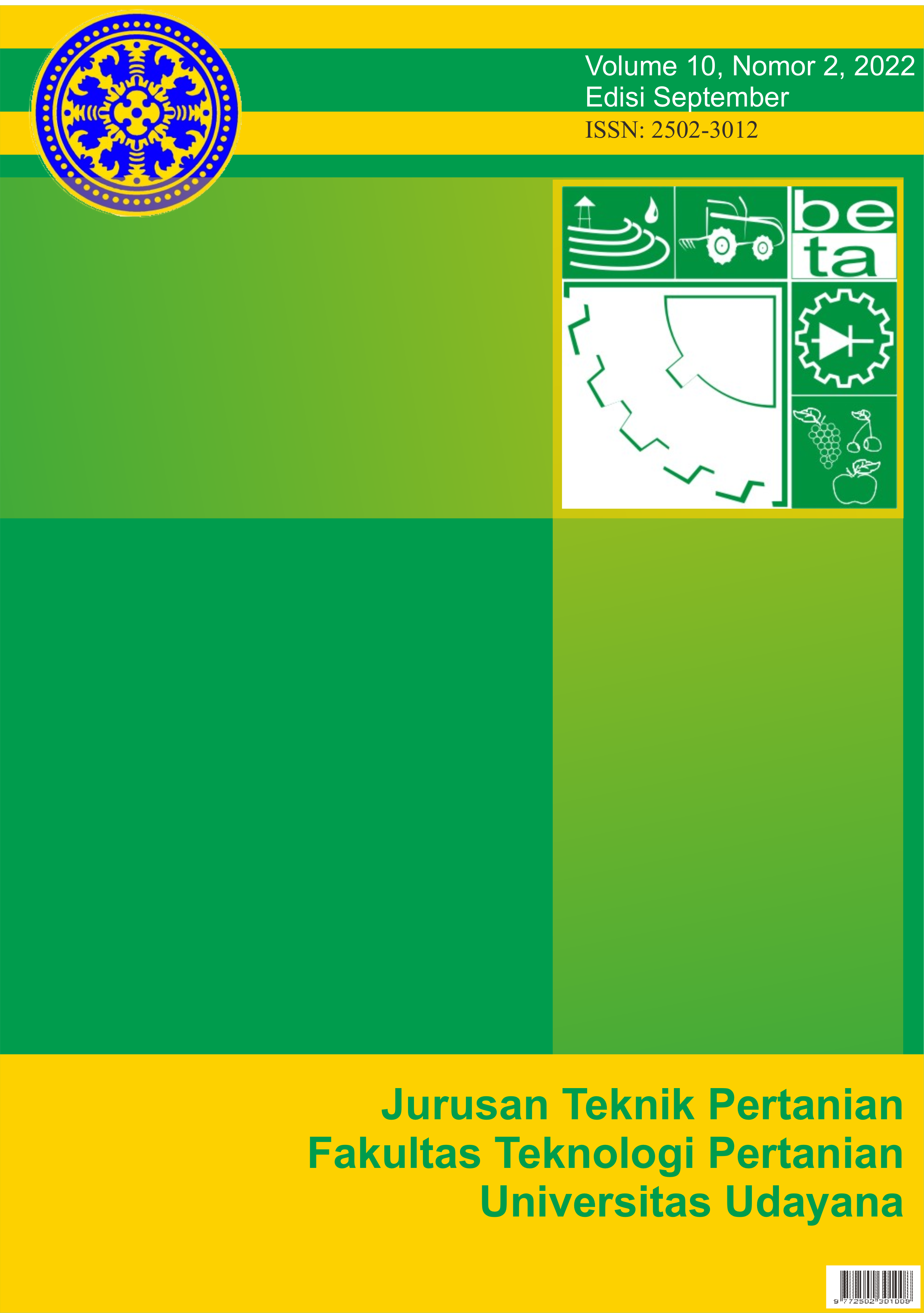Effects of The Proportion of The LED Light Red, Blue, and White Colors on Chlorophyll Content and Canopy Area of Pakcoy (Brassica rapa L.)
Abstract
Abstract
Light is the main energy source for plants for the photosynthesis process. In indoor cultivation systems (plant factories), LEDs can be used as artificial light. The dominant light colors absorbed by plants for the photosynthesis process are red and blue, but the proportion of the LED colors used is unknown, so it is necessary to research the proportions of light colors. This study aims to determine the effect of the proportions of red, blue, and white light on the chlorophyll content (SPAD value) and the canopy area of Pakcoy. Pakcoy was planted in a growth chamber and given seven different proportions of light for 12 hours with a lamp total of 60 Watt and light intensity of 2000 lux. This study was conducted for 49 days, and the observations to make once a week. The results showed the proportion of red, blue, and white LED light treatment affects the chlorophyll content and canopy area. The proportions of LED light 30 Watt red, 20 Watt blue, and 10 Watt white produced the highest chlorophyll content (35.0 SPAD value) and canopy area (70.7 cm2). In conclusion, the proportion of red, blue, and white LED light showed significantly different in the growth of Pakcoy.
Downloads
References
Bayat, L., Arab, M., Aliniaeifard, S., Seif, M., Lastochkina, O., and Li, T. 2018. Effects of growth under different light spectra on the subsequent high light tolerance in rose plants. AoB PLANTS, 10(5):1–17. https://doi.org/10.1093/aobpla/ply052
Chen, L. Li, Zhang, K., Gong, X. Chen, Wang, H. Ying, Gao, Y. Hui, Wang, X. Quan, Zeng, Z. Hai, and Hu, Y. Gao. 2020. Effects of different LEDs light spectrum on the growth, leaf anatomy, and chloroplast ultrastructure of potato plantlets in vitro and minituber production after transplanting in the greenhouse. Journal of Integrative
Agriculture, 19(1):108–119. https://doi.org/10.1016/S2095-3119(19)62633-X
Haryanti, S. 2008. Growth response of patchouli (Pogostemon cablin Benth) leaf number and size on different levels of shade. Anatomy and Physiologi Bulletin, 16(2):20–26. https://ejournal.undip.ac.id/index.php/janafis/article/view/2590
Haryanto, E., Suhartini, T., Sunarjono, H., and Rahayu, E. 2006. Sawi and Selada. Penebar Swadaya.
Hendriyani, I. S., and Setiari, N. 2009. Kandungan klorofil dan pertumbuhan kacang panjang (Vigna sinensis) pada tingkat penyediaan air yang berbeda. Artikel Penelitian, 17(3):145–150.
Kobayashi, K., Amore, T., and Lazaro, M. 2013. Light-Emitting Diodes (LEDs) for miniature hydroponic lettuce. Optics and Photonics Journal, 03(01):74–77. https://doi.org/10.4236/opj.2013.31012
Kwon, S. Y., Ryu, S. H., and Lim, J. H. 2014. Design and implementation of an integrated management system in a plant factory to save energy. Cluster Computing, 17(3):727–740. https://doi.org/10.1007/s10586-013-0295-2
Li, R., Guo, P., Baum, M., Grando, S., and Ceccarelli, S. 2006. Evaluation of chlorophyll content and fluorescence parameters as indicators. Agricultural Sciences in China, 5: 751–757.
Lin, K. H., Huang, M. Y., Huang, W. D., Hsu, M. H., Yang, Z. W., and Yang, C. M. 2013. The effects of red, blue, and white light-emitting diodes on the growth, development, and edible quality of hydroponically grown lettuce (Lactuca sativa L. var. capitata). Scientia Horticulturae, 150:86–91. https://doi.org/10.1016/j.scienta.2012.10.002
Lindawati, Y., Triyono, S., and Suhandy, D. 2015. Pengaruh lama penyinaran kombinasi lampu led dan lampu neon terhadap pertumbuhan dan hasil tanaman pakcoy (Brassica rapa L.) dengan hidroponik sistem sumbu (wick system). Jurnal Teknik Pertanian Lampung, 4(3):191–200. https://pdfs.semanticscholar.org/36af/adca1000970b40e3944b1dcd7eb6ab67c939.pdf
Morrow, R. C. 2008. LED lighting in horticulture. HortScience, 43(7):1947–1950. https://doi.org/10.21273/hortsci.43.7.1947
Nio Song, A., and Banyo, Y. 2011. Konsentrasi klorofil daun sebagai indikator kekurangan air pada tanaman. Jurnal Ilmiah Sains, 15(1):166. https://doi.org/10.35799/jis.11.2.2011.202
Nugroho, A. P. 2019. Pengembangan Sistem Monitoring Tumbuh-Kembang Tanaman Secara Presisi pada Plant Factory. Smart Farming Teknik Pertanian and Biosistem Universitas Gadjah Mada.
Nurcahyani, E., Rahmadani, D. D., and Wahyuningsih, S. 2020. Analisis kadar klorofil pada buncis (Phaseolus vulgaris L.) terinduksi indole acetic acid (IAA) secara in vitro. Journal Analytical and Environmental Chemistry, 5(01):15–23.
Poincelot, R. P. 1980. Horticulture: principles and practical applications. Prentice-Hall Inc..
Runkle, E. 2015. Light wavebands and their effects on plants. Gpn, March, 2015.
Sigmarawan, T. G., Wijaya, I. M. A. S., and Budisanjaya, I. P. G. 2020. Musik gamelan gong kebyar dan cahaya LED (light emitting diode) merah-biru meningkatkan pertumbuhan dan produktivitas sawi pakcoy (Brassica rapa L.). Jurnal BETA (Biosistem Dan Teknik Pertanian), 28(2):1–43.
Soeleman, S., and Donor, R. 2013. Halaman organik: mengubah taman rumah menjadi taman sayur an organik untuk gaya hidup sehat. PT AgroMedia Pustaka.
Syafriyudin, and Ledhe, N. T. 2015. Analisis pertumbuhan tanaman krisan pada variabel warna cahaya lampu LED. Jurnal Teknologi, 8(1):83–87.
Wanita, Y. P., and Afriani, R. 2020. The chlorophyll content, weight loss, and production of pakcoy in several farming system. E3S Web of Conferences, 142:4–7. https://doi.org/10.1051/e3sconf/202014201005
Wenno, S. J., and Sinay, H. 2019. Kadar klorofil daun pakcoy (Brassica Chinensis L.) setelah perlakuan pupuk kandang dan ampas tahu sebagai bahan ajar mata kuliah fisiologi tumbuhan. Biopendix: Jurnal Biologi, Pendidikan Dan Terapan, 5(2):130–139. https://doi.org/10.30598/biopendixvol5issue2year2019
Wicaksono, G. 2014. Pengaruh pemberian spektrum cahaya berbeda terhadap kandungan klorofil Spirulina sp. Universitas Airlangga. http://journal.unair.ac.id/filerPDF/marine74aa1e371afull.pdf
Wiguna, I. K. W., Wijaya, I. M. A. S., and Nada, I. M. 2015. Pertumbuhan tanaman krisan (Crhysantemum) dengan berbagai penambahan warna cahaya lampu led selama 30 hari pada fase vegetatif. BETA (Biosistem Dan Teknik Pertanian), 3(2):1–11.












 Jurnal BETA (Biosistem dan Teknik Pertanian)
Jurnal BETA (Biosistem dan Teknik Pertanian)


